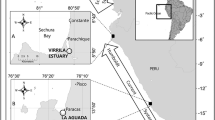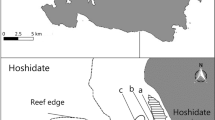Abstract
Studies of feeding grounds are vital to understanding the ecology and conservation issues of sea turtles. The hypersaline, lake Bardawil, of North Sinai has recently been recognized as being a major feeding ground for sea turtles in the Mediterranean Sea. The objective of this research was to examine if the environmental variables (salinity, dissolved oxygen, and depth), distance to nearest Mediterranean inlet, and food availability (zooplankton and phytoplankton density) differed between areas according to species richness (green (Chelonia mydas) and loggerhead (Caretta caretta) turtles, single species, no species) and between areas in which loggerhead and green turtles were observed and not observed. Our results highlight the importance of environmental factors determining the distribution of endangered sea turtles as areas with high sea turtle richness had lower salinity, higher dissolved oxygen, were deeper and located closer to the nearest Mediterranean inlet. Our results support the suggestion that since the creation of the man-made inlets from the Mediterranean Sea, the environmental conditions of the hypersaline lake Bardawil have become less severe and more suitable for sea turtles as a feeding ground. The conservation of this biologically valuable lake will require active management to protect it from the increasing anthropogenic threats that will encroach upon the lake in the next decade.




Similar content being viewed by others
References
Abd El-Hady HH, Khalifa N (2015) Phytoplankton biochemical contents and zooplankton composition in vegetated and non-vegetated regions in Bardawil Lagoon, North Sinai, Egypt. I J Fish Aquat 2:46–54
Abd Ellah RG, Hussein MG (2009) Physical Limnology of Bardawil Lagoon, Egypt. American-Eurasian J Agric. Environ Sci 5:331–336
Anufriieva E, El-Shabrawy G, Shadrin N (2018) Copepoda in the shallow hypersaline Bardawil coastal lake (Egypt): Are there long-term changes in composition and abundance. Oceanol Hydrobiol St 47:219–229
Arthur K, Boyle M, Limpus C (2008) Ontogenetic changes in diet and habitat use in green sea turtle (Chelonia mydas) life history. Mar Ecol Prog Ser 362:303–311
Attum O, Baha El Din M, Baha El Din S, Habinan S (2007) Egyptian tortoise conservation: a community-based, field research program developed from a study on a semi-captive population. Zoo Biol 26:397–406
Bradshaw P, Broderick A, Carreras C, Inger R, Fuller W, Snape R, Stokes K, Godley B (2017) Satellite tracking and stable isotope analysis highlight differential recruitment among foraging areas in green turtles. Mar Ecol Prog Ser 582:201–214
Cardona L, Campos P, Levy Y, Demetropoulos A, Margaritoulis D (2010) Asynchrony between dietary and nutri- tional shifts during the ontogeny of green turtles (Chelonia mydas) in the Mediterranean. J Exp Mar Bio Ecol 393:83–89
Craig KJ, Crowder LB, Gray CD, McDaniel CJ, Kenwood TA, Hanifen JG (2001) Ecological effects of hypoxia on fish, sea turtles and marine mammals in the northwestern Gulf of Mexico. In: Rabalais NN, Turner RE (eds) Coastal Hypoxia: Consequences for Living Resources and Ecosystems. pp 269–292. https://doi.org/10.1029/CE058p0269
El-Bana M, Khedr A, Hecke JV, Bogaert J (2002) Vegetation composition of a threatened hypersaline lake (Lake Bardawil). North Sinai. Plant Ecology 163:63–75
Fouda M, Saab M, Saleh M (1987) An extensive study of plankton in the Bardawil lagoon, Egypt. Leban Sci Bull 3:5–23
Geneid YA, El-Hady HH (2006) Distribution, biomass and biochemical contents of the seagrass species of Lake Bardawil, Mediterranean Sea, Egypt. Biol Mar Medit 13(4):225–229
Groombridge B, Luxmoree R (1989) The green turtle and hawksbill (Reptilia: Cheloniidae): World status, exploitation, and trade. CITES Secretariat, Lausanne, Switzerland, p 601
Hays G, Glen F, Broderick A, Godley B, Metcalfe J (2002) Behavioural plasticity in a large marine herbivore: contrasting patterns of depth utilization between two green turtle (Cheloniamydas) populations. Mar Biol 141:985–990
Hazel J, Lawler I, Hamann M (2009) Diving at the shallow end: Green turtle behaviour in near-shore foraging habitat. J Exp Mar Biol Ecol 371:84–92
Houghton JDR, Callow MJ, Hays GC (2003) Habitat utilization by juvenile hawksbille turtles (Eretmochelys imbricata, LInnaeus, 1766) around a shallow water coral reef. J Nat Hist 37:1269–1280
Khalil M, Saad A, Fishar M, Bedir T (2013) (2013) Ecological Studies on Macrobenthic Invertebrates of Bardawil Wetland, Egypt. World Environment 3(1):1–8. https://doi.org/10.5923/j.env.20130301.01
Khalil MT, Abd El-Halim AS, Ahmed MHM, El Kafrawy SB, Emam WWM (2016) Integrated Field Study, Remote Sensing and GIS Approach for Assessing and Monitoring Some Chemical Water Quality Parameters in Bardawil Lagoon. Egypt 5:14656–14669
Kock V, Peckham H, Mancini A, Eguchi T (2013) Estimating at-sea mortality of marine turtles from stranding frequencies and drifter experiments. PLOS One 8:E56776
Lamptey E, Armah A (2008) Factors affecting macrobenthic fauna in a tropical hypersaline coastal lagoon in Ghana, West Africa. Estuar Coast 31:1006–1019
Mageed A (2006) Spatio-temporal variations of zooplankton community in the hypersaline lagoon of Bardawil, north Sinai–Egypt. Egypt J Aquat Res 1687–4285 vol 32 no 1: 168–183
Mancini A, Elsadek I, Madon B (2015) When simple is better: Comparing two sampling methods to estimate green turtles abundance at coastal feeding grounds. J Exp Mar Biol Ecol 465:113–120
Mehanna S, Hegazi M (2013) Population dynamics of grey mullet Mugil cephalus associated with seagrass community in Bardawil lagoon, Northern Sinai, Egypt. In: Proceedings, INOC -IIUM- International Conference on “Oceanography & Sustainable Marine Production: A Challenge of Managing Marine Resources under Climate Change, ICOSMaP,”, vol 2013, Kuantan-Malaysia, pp 28, 530–30, 539
Moran K, Bjorndal K (2005) Simulated green turtle grazing affects structure and productivity of seagrass pastures. Mar Ecol Prog Ser 305:235–247
Moran K, Bjorndal K (2007) Simulated green turtle grazing affects nutrient composition of the seagrass Thalassia testudinum. Mar Biol 150:1083–1092
Nada MA, Boura L, Grimanis K, Schofield G, El-Alwany MA, Noor N, Ommeran, MM, Rabia B (2013). Egypt’s Bardawil Lake: safe haven or deadly trap for sea turtles in the Mediterranean? A report by MEDASSET, Suez Canal University and Nature Conservation Egypt, p 79
Rabia B, Attum O (2015) Distribution and status of sea turtle nesting and mortality along the North Sinai coast, Egypt (Reptilia: Cheloniidae). Zool Middle East 61:26–31
Schofield G, Bishop C, MacLean G, Brown P, Baker M, Katselidis K, Dimpoulos P, Pantis J, Hays G (2007) Novel GPS tracking of sea turtles as a tool for conservation management. J Exp Mar Biol Ecol 347:58–68
Seminoff JA, Jones TT, Resendiz A, Nichols WJ, Chaloupka ML (2003) Monitoring Green turtles (Chelonia mydas) at a coastal foraging area in Baja California, Mexico: multiple indices describe population status. J Mar Biol Assoc UK 83:1335–1362
Senko J, Koch V, Megill WM, Carthy RR, Templeton RP, Nichols WJ (2010) Fine scale daily movements and habitat use of East Pacific green turtles at a shallow coastal lagoon in Baja California Sur. Mexico. J Exp Mar Biol Ecol 391:92–100
Shadrin N, Anufriieva E, Amat F, Eremin O (2015) Dormant stages of crustaceans as a mechanism of propagation in the extreme and unpredictable environment in the Crimean hypersaline lakes. Chin J Oceanol Limn 33:1362–1367
Shadrin NV (2017) Hypersaline lakes as polyextreme habitats for life. In: Zheng M, Deng T, Oren A (eds) Introduction to salt lake sciences. Science Press, Beijing, pp 173–178
Acknowledgments
We would like to thank the Egyptian Environmental Affairs Agency and Indiana University Southeast for their continued support. We would like to thank Wessam ElShohty, Nature Conservation Sector and Hany Al Nagar, Zaranik Protected Area for their assistance in the field.
Author information
Authors and Affiliations
Corresponding author
Ethics declarations
Conflict of interest
We explicitly declare that they have no conflict of interest. This research was funded internally and all necessary approvals have been obtained.
Additional information
Publisher’s note
Springer Nature remains neutral with regard to jurisdictional claims in published maps and institutional affiliations.
Rights and permissions
About this article
Cite this article
Attum, O., Rabia, B. Green (Chelonia mydas) and loggerhead (Caretta caretta) habitat use of the most environmentally extreme sea turtle feeding ground in the Mediterranean basin. J Coast Conserv 25, 4 (2021). https://doi.org/10.1007/s11852-020-00793-1
Received:
Revised:
Accepted:
Published:
DOI: https://doi.org/10.1007/s11852-020-00793-1




